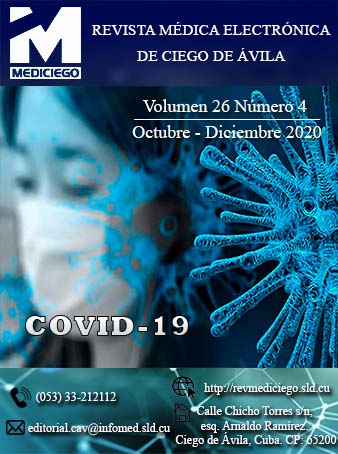Effectiveness of acupuncture transcutaneous electrical stimulation in reducing pain in hemiplegic patients with painful shoulder
Keywords:
TERAPIA ELÉCTRICA TRANSCUTÃNEA ACUPUNTURAL, ESTIMULACIÓN ELÉCTRICA TRANSCUTÃNEA DEL NERVIO, TERAPIA POR ESTIMULACIÓN ELÉCTRICA/métodos, DOLOR DE HOMBRO/ rehabilitación, HEMIPLEJÃA/rehabilitaciónAbstract
Introduction: when complications such as shoulder subluxation appear in hemiplegic patients with painful shoulder, it is necessary to explore the benefits of electrotherapy through acupuncture transcutaneous electrical stimulation.
Objective: to evaluate the effectiveness of acupuncture transcutaneous electrical stimulation in reducing pain intensity in hemiplegic patients with painful shoulder.
Methods: a pre-experimental before-after study was carried out in hemiplegics with painful shoulder, belonging to the health area of Chambas, Ciego de Ávila, in the period between July 2017 and December 2018. The study universe consisted of 49 adults with painful shoulder, whose imaging studies showed vascular hemiplegia. To evaluate the pain variable, the visual analog scale was used; and for muscle tone, the Ashworth scale. The ethical principles of the research were complied with.
Results: the female sex predominated (67,35 %), there were no significant differences in the mean ages between the sexes. The condition in the right hemibody (65,38 %) predominated as dominant, with no statistical relationship between the two. No association was found between shoulder subluxation and muscle tone (p =0,883), as well as moderate hypertonia (42,86 %). Pain intensity and independence in activities of daily living showed positive and significant evolutionary changes in evaluations as a function of time (p =0,000). There were no adverse effects.
Conclusions: electrotherapy through acupuncture transcutaneous electrical stimulation showed effectiveness in the treatment of painful shoulder in hemiplegic patientsDownloads
Published
How to Cite
Issue
Section
License
Copyright (c) 2021 Onesio Esteban de León Gutiérrez

This work is licensed under a Creative Commons Attribution-NonCommercial 4.0 International License.
Those authors who have publications with this journal accept the following terms of the License CC Attribution-NonCommercial 4.0 International (CC BY-NC 4.0):
You are free to:
- Share — copy and redistribute the material in any medium or format for any purpose, even commercially.
- Adapt — remix, transform, and build upon the material for any purpose, even commercially.
The licensor cannot revoke these freedoms as long as you follow the license terms.
Under the following terms:
- Attribution — You must give appropriate credit , provide a link to the license, and indicate if changes were made . You may do so in any reasonable manner, but not in any way that suggests the licensor endorses you or your use
- No additional restrictions — You may not apply legal terms or technological measures that legally restrict others from doing anything the license permits.
The journal is not responsible for the opinions and concepts expressed in the works, which are the exclusive responsibility of the authors. The Editor, with the assistance of the Editorial Committee, reserves the right to suggest or request advisable or necessary modifications. Original scientific works are accepted for publication, as are the results of research of interest that have not been published or sent to another journal for the same purpose.
The mention of trademarks of specific equipment, instruments or materials is for identification purposes, and there is no promotional commitment in relation to them, neither by the authors nor by the editor.






















